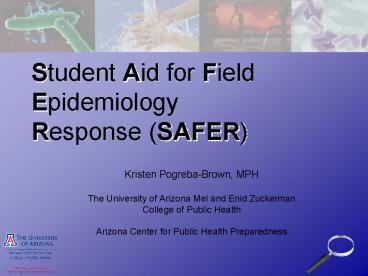Student Aid for Field Epidemiology Response SAFER - PowerPoint PPT Presentation
1 / 17
Title:
Student Aid for Field Epidemiology Response SAFER
Description:
Skills needed in an outbreak investigation. Critical training needs. Student participation ... Time in which students are needed following notification ... – PowerPoint PPT presentation
Number of Views:47
Avg rating:3.0/5.0
Title: Student Aid for Field Epidemiology Response SAFER
1
Student Aid for Field Epidemiology Response
(SAFER)
- Kristen Pogreba-Brown, MPH
- The University of Arizona Mel and Enid Zuckerman
- College of Public Health
- Arizona Center for Public Health Preparedness
2
What is SAFER?
- SAFER is made up of a group of enthusiastic
graduate students who are interested in learning
more about how local health departments conduct
outbreak investigations - Students are available to take part in emerging
and continuing disease investigations along with
state public health professionals
3
Why is it Important for Students to Study
Outbreaks?
- Important Public Health training
- Gain real world experience
- Assist local health departments
- Collaborate with local health departments
- Internship opportunities
- Career contacts
4
Background on the Team
- Needs assessment of local health departments
- Summary of interview findings
- Program development
- Team piloted with 15 graduate students in Spring
2005 - Establishment of an outbreak response course tied
to team membership
5
Needs Assessment
- Interviews at AZ Health Departments
- Information collected on
- Skills needed in an outbreak investigation
- Critical training needs
- Student participation
- Legal and safety issues
- Funding possibilities
6
Summary of Interview Findings
- Potential student activities
- Training needs
- Importance of having students well trained before
taking part in a response - Topics on which students should be trained
- Concerns/Issues to Address
- Maintaining confidentiality and HIPPA
requirements - Being prepared for the field
- Personnel to perform training sessions
- Funding issues
- Travel and lodging costs if necessary
- Any costs associated with training
7
Program Synopsis
- Team membership
- Required training on surveillance and outbreak
response at ADHS and MCDPH - Student participation in outbreak response class
- ICS 100 and ICS 700 training required
- Advisory group
- Response Notification Systems
- Evaluations Systems
8
Health Department Responsibilities
- To contact the program coordinator as needed
- To provide training/orientation at the beginning
of each school semester for new team members (For
partnering agencies only) - To provide some instruction and supervision to
student volunteers when they arrive on site - To maintain an expectation of temporary (1-3
days) commitments from students unless previously
determined to be longer - To complete the response evaluation of student
participation
9
Class Description
- Interactive seminars that bring in public health
professionals to share their investigation
experiences with the students - Outbreak Activities/Training Sessions
- Preparedness Activities/Training Sessions
- Short-term projects for returning students
10
Training Sessions
- Arizona Department of Health Services (Infectious
Epidemiology Division) - Students must complete a full day training
session covering the basics of surveillance,
reporting procedures and how different types of
outbreak investigations are conducted - Maricopa County Health Department
- Focuses on food borne outbreak investigations and
interviewing skills - Pima County Health Department
- Introduction to local health department,
conducting interviews from a call center, and
Incident Command structures and the EOC
11
Activation of the Team
12
Potential Activities for Students
- Interviews
- Data Management
- Communicating with the public
- Sample collection and transportation
- Case-control studies
- Taking part in preparedness drills
- Chart Reviews
- Field Work
- Short Term Projects
13
What SAFER Has Done
- Norvirus, Norvirus, Norovirus
- Grand Canyon river rafters
- Assisted care facilities
- Weddings, catered events, conferences, anywhere
lots of people gather and eat - Pertussis outbreak
- Hepatitis A outbreak
- Salmonella, Shigella, MRSA Measles outbreak
- West Nile Virus Surveillance
- Gem Show Surveillance
- Real-Time Syndromic Surveillance at Super Bowl
XLII - Unknowns
- POD Training and Participation
14
Real-Time Syndromic Surveillance at Super Bowl
XLII
15
Student Commitments
Total of 463 hours over 7 semesters
16
Challenges
- Student schedules
- Developing trust among health departments
- Establishing protocols
- Not enough people getting sick and reporting it
to the health departments
17
Questions?
Kristen Pogreba-Brown kpogreba_at_email.arizona.edu































